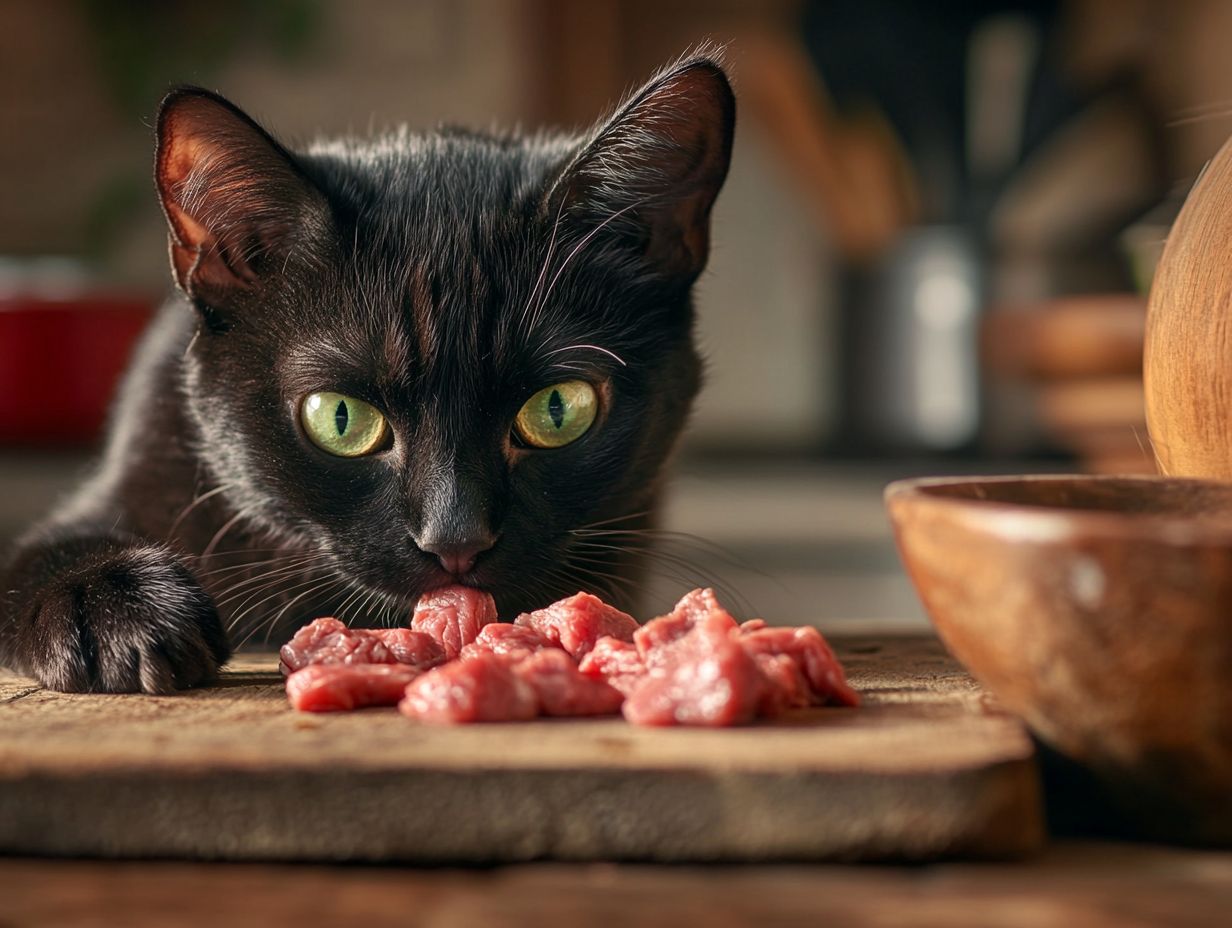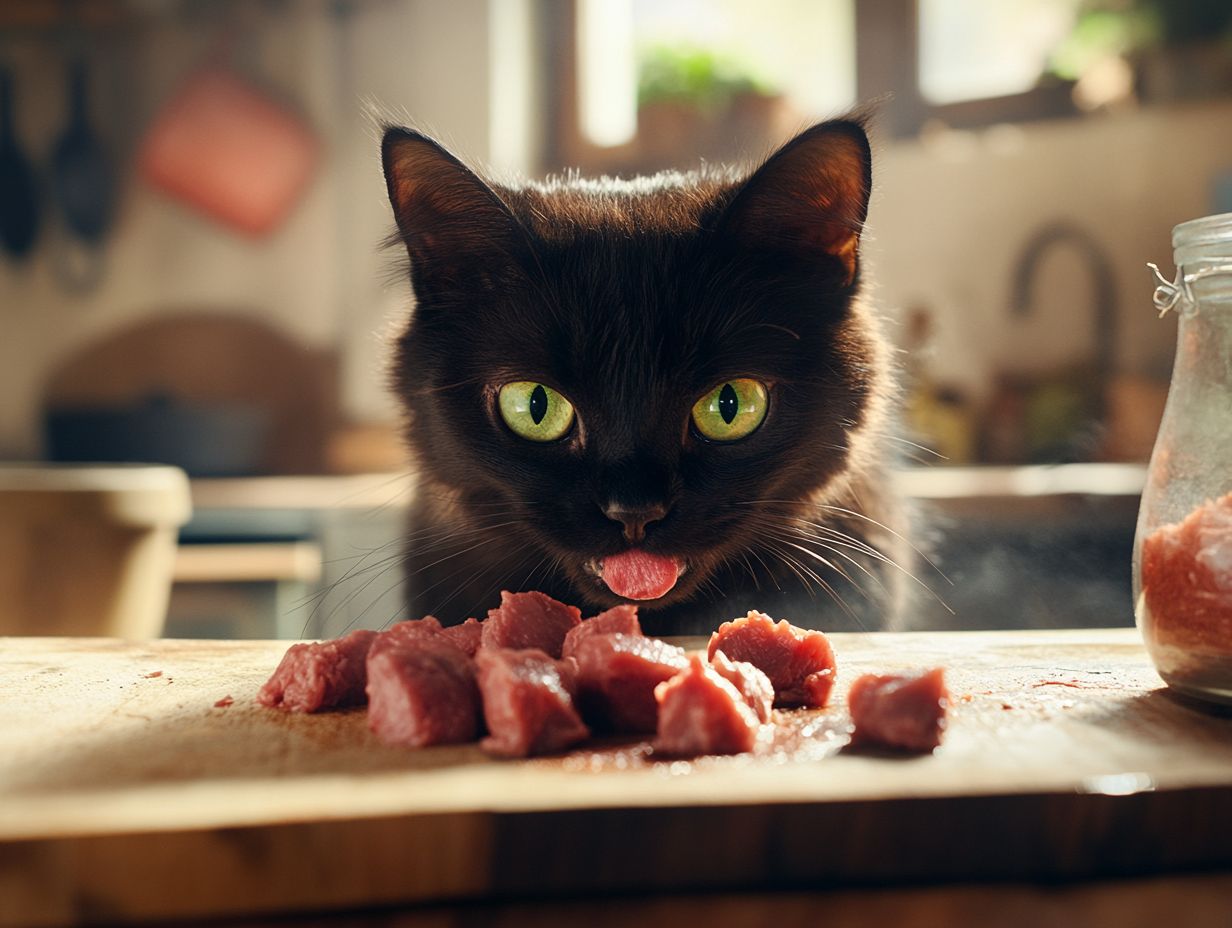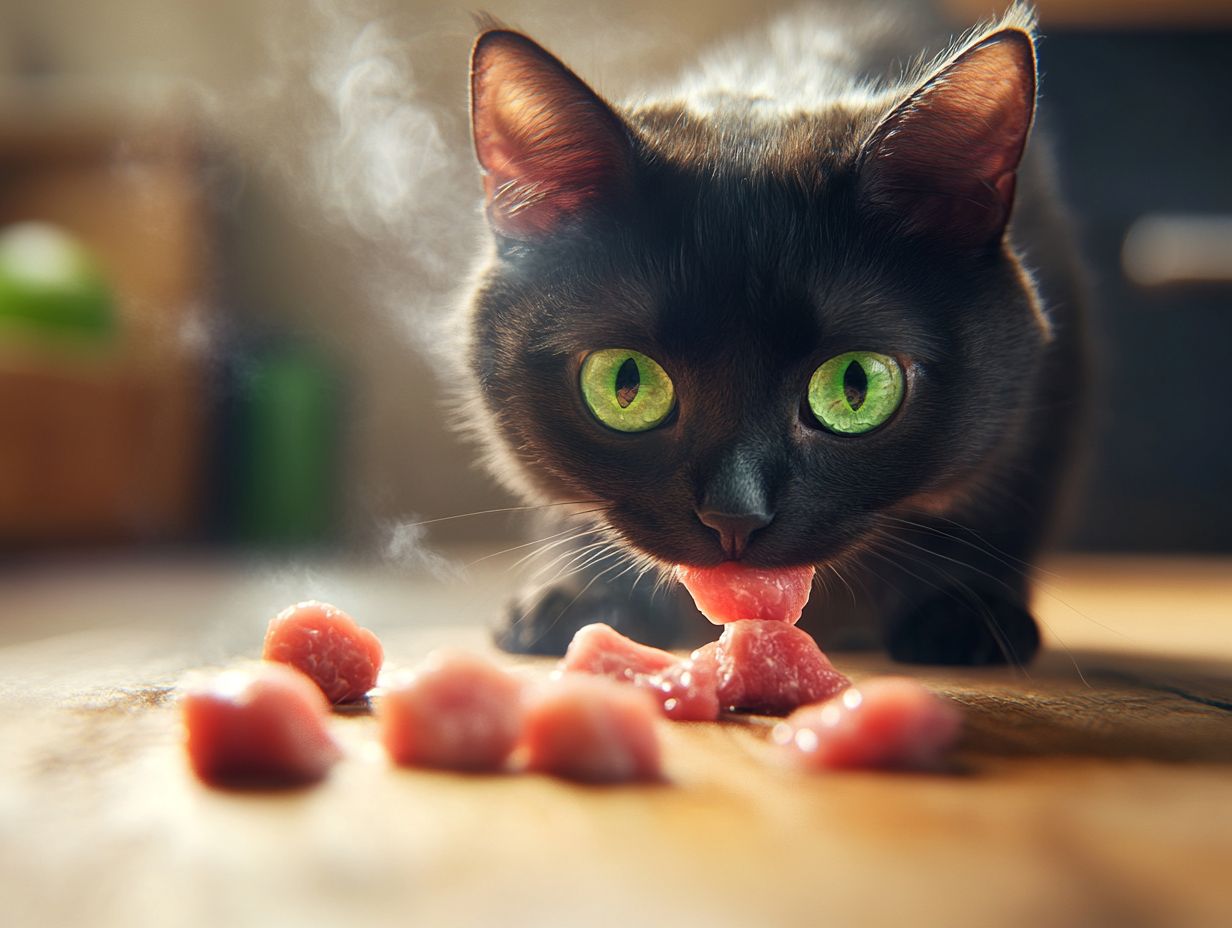As a cat owner, you may have wondered about the benefits and risks of feeding your feline friend raw beef. This article aims to provide a balanced understanding of these aspects, helping you make informed dietary decisions. This topic raises important concerns among pet enthusiasts and veterinarians alike.
While some argue that raw beef can provide essential nutrients and health benefits, others raise concerns about food safety and potential health risks.
This article will explore both sides of the argument, share safety tips for preparation and storage, and suggest alternative protein sources to ensure your cat maintains a balanced diet. Your cat’s health is paramount, so let’s uncover the facts together.
Key Takeaways:

- Feeding cats raw beef is a controversial topic with valid arguments for and against.
- Raw beef can pose food safety risks; proper preparation and storage are crucial.
- Consult with a veterinarian before introducing raw beef into your cat’s diet.
The Debate on Feeding Cats Raw Beef
The debate over feeding cats raw beef revolves around their nutritional needs—cats are strict meat-eaters that need high-quality animal protein to thrive—versus the inherent risks associated with a raw diet. While raw diets can meet their protein needs, there are health risks that need to be considered. As strict meat-eaters, cats require high-quality animal protein, which can include raw meat.
Pet owners must weigh the advantages and disadvantages of a raw diet against potential health complications. It is essential for them to consult a veterinarian to ensure that their cat’s nutritional needs are met safely, without compromising the safety associated with raw diets.
Arguments for and Against
Arguments for Feeding Cats Raw Beef
Cats have a high protein requirement that can be met through raw diets. Raw beef provides a protein source rich in essential amino acids, such as taurine and arginine, which are crucial for muscle development, enzyme structure, and overall vitality. Many pet owners believe that raw meat may be easier for cats to digest than cooked meat. Additionally, many believe that feeding cats raw diets can lead to improved coat condition and increased energy levels.
Arguments Against Feeding Cats Raw Beef
Despite the benefits, there are significant downsides to feeding cats raw beef. One major concern is pathogen contamination; raw beef can harbor harmful bacteria such as Salmonella and E. coli, which pose serious health risks to pets and can potentially be transmitted to humans. Another drawback is the possibility of dietary allergies, as introducing new protein sources can lead to the development of allergies in some cats. Always ensure that any raw meat is sourced from reputable suppliers to minimize contamination risks.
When considering whether to feed cats raw beef, it’s essential to weigh these pros and cons carefully, taking into account the nutritional requirements and potential food hazards. For more information, check out Can Cats Eat Raw Beef? What You Need to Know.
Potential Risks of Feeding Cats Raw Beef

Yes, feeding cats raw beef carries potential risks, including high levels of pathogen contamination that can lead to health issues in cats. Symptoms to watch for if a cat is affected by foodborne pathogens include vomiting, diarrhea, lethargy, and loss of appetite.
Food Safety Concerns
Food safety concerns are significant when it comes to including raw beef in a cat’s diet, primarily due to the health risks posed by pathogens to both animals and humans. This risk is heightened when raw ingredients are improperly handled or sourced, potentially exposing both people and pets to unsafe food practices.
Statistics indicate that nearly 60% of raw pet food samples can be contaminated with harmful bacteria such as Salmonella and E. coli, underscoring the importance of safe food handling practices. Always wash hands and surfaces after handling raw meat to reduce contamination risks. It is essential to consult a veterinarian before introducing any raw diets, as they are best equipped to provide recommendations on safe sourcing and preparation methods.
Maintaining the integrity of the ingredients not only safeguards the feline family members but also protects the entire household by reducing the risk of cross-contamination.
Benefits of Feeding Cats Raw Beef
Always prioritize your cat’s health by consulting a veterinarian before making any significant dietary changes.
Feeding cats raw beef offers several benefits, as it is high in protein and essential amino acids that support their evolution as meat-eating animals, particularly in terms of balanced nutrition.
Nutritional Value and Potential Health Benefits
Raw beef offers significant nutritional benefits for cats, providing high-quality animal protein and moisture that contribute positively to their overall health. It is also rich in essential amino acids, such as taurine, which are crucial for heart health and proper vision in cats. A safe portion size for raw beef can be around 1 ounce per 5 pounds of body weight, but it’s always best to consult a veterinarian for specific recommendations.
Additionally, raw fats from meat are important as they supply energy and promote a shiny coat. Pet owners who feed their cats raw meat-based diets have reported improvements in their pets’ digestion and vitality.
How to Safely Feed Cats Raw Beef
Feeding cats raw beef can be safe, provided that pet owners adhere to proper preparation and storage guidelines to minimize food hazards and safeguard their cats’ health.
Tips for Proper Preparation and Storage

Proper preparation and storage are crucial for feeding cats raw meat, as they directly impact food safety and the health of the animal. To ensure that raw beef remains uncontaminated and safe, it is essential to start by cleaning and sanitizing all surfaces and utensils that will come into contact with the meat. It is advisable to use separate utensils and cutting boards for raw meat and other foods to avoid cross-contamination.
When thawing meat, it should be done in the refrigerator or submerged in cold water, rather than left out on the counter at room temperature, to prevent bacterial growth.
Raw meat must be stored at temperatures below 40 degrees Fahrenheit and should be used within a few days or frozen for later use. Veterinarians can provide tailored recommendations and instructions to ensure that this feeding method is safe and nutritionally appropriate for individual pets.
Alternatives to Raw Beef for Cats
For cat owners who wish to provide a balanced diet while minimizing the risks associated with raw feeding, considering alternatives is essential. High-quality commercial diets can deliver essential animal protein without the risks associated with raw feeding. These diets are formulated to meet the nutritional needs of cats effectively.
Other Protein Sources for a Balanced Diet
Cooked options such as chicken, turkey, or fish can provide safe and nutritious substitutes, as these meats are rich in essential amino acids that support muscle development and overall health.
For those considering a plant-based approach, legumes and certain grains can serve as complementary ingredients; however, they should be balanced with animal proteins, such as raw beef, to ensure all necessary nutrients are included.
Additionally, dairy products like cottage cheese can be used in moderation to provide an alternative source of protein and calcium. It is essential to monitor the nutritional profile of any chosen diet to prevent deficiencies and promote the cat’s well-being.
Frequently Asked Questions
Can cats eat raw beef?
Yes, cats can eat raw beef. Cats are natural carnivores, and raw beef is a great source of protein for them. However, there are some precautions to keep in mind before feeding raw beef to your cat. Always consult your veterinarian for guidance.
What are the risks of feeding raw beef to cats?

The main risk of feeding raw beef to cats is the potential for bacterial contamination, such as Salmonella or E. coli. These bacteria can cause food poisoning in cats and can also be passed on to humans through handling or contact with the cat’s feces. It is crucial to follow safety guidelines and consult a veterinarian.
Is it safe for my cat to eat raw beef from the grocery store?
No, it is not recommended to feed your cat raw beef from the grocery store. This meat is usually intended for human consumption and may not be suitable for cats. It is also more likely to contain bacteria that can harm your cat.
Disclaimer: While some cats can thrive on raw diets, they may not be suitable for all cats, especially those with certain health conditions. Always consult with a veterinarian to determine the best diet for your feline friend.
In conclusion, while raw beef can offer nutritional benefits for cats, pet owners should be vigilant about preparation and safety. Key takeaways include the importance of consulting a vet before making dietary changes, understanding the risks of raw feeding, and considering safe alternatives. By following these guidelines, you can help ensure that your cat remains healthy and thriving.